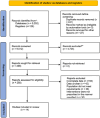Left Bundle Branch Area Pacing Versus Right Ventricular Pacing in Patients With Atrioventricular Block: A Systematic Review and Meta-Analysis
- PMID: 39775893
- PMCID: PMC11837886
- DOI: 10.1111/jce.16548
Left Bundle Branch Area Pacing Versus Right Ventricular Pacing in Patients With Atrioventricular Block: A Systematic Review and Meta-Analysis
Abstract
Background: Left bundle branch area pacing (LBBAP) is a new technique for patients with atrioventricular block (AVB) and preserved left ventricular ejection fraction (LVEF), potentially offering better cardiac function than right ventricular pacing (RVP).
Methods: We searched databases and registries for studies that compared LBBAP with RVP in patients with AVB and preserved LVEF. We extracted data on various outcomes and pooled the effect estimates using random-effects models.
Results: Our meta-analysis included 14 studies (10 observational and 4 RCTs) involving 3062 patients with AVB. The analysis revealed that the QRS duration was significantly shorter in the LBBAP group compared to the RVP group [MD = -35.56 ms; 95% CI: (-39.27, -31.85), p < 0.00001]. Patients in the LBBAP group also exhibited a significant increase in left ventricular ejection fraction (LVEF) [MD = 5.48%; 95% CI: (4.07%, 6.89%), p < 0.00001], and a significant reduction in left ventricular end-diastolic diameter (LVEDD) compared to RVP [MD = -3.98 mm; 95% CI: (-5.88, -2.09 mm), p < 0.0001]. In terms of clinical outcomes, LBBAP was associated with a significantly lower risk of heart failure hospitalizations (HFHs) compared to RVP [OR = 0.26; 95% CI: (0.16, 0.44), p < 0.0001]. However, no significant differences were observed between the two groups in the implant success rate, pacing impedance, or pacing threshold. The RVP group demonstrated a significantly higher R-wave amplitude increase than the LBBAP group [MD = 0.85 mV; 95% CI: (0.23, 1.46), p = .007]. Lastly, there was no significant difference in the incidence of complications between the two groups [OR = 2.12; 95% CI: (0.29, 15.52), p = 0.46].
Conclusion: LBBAP outperforms RVP in several cardiac function indicators, suggesting it may be a superior pacing method for AVB patients with preserved LVEF. However, the small sample size in studies and the result in heterogeneity call for more research to validate these findings and assess LBBAP's long-term effects.
Keywords: cardiac resynchronization therapy; left bundle branch pacing; right ventricular pacing.
© 2025 The Author(s). Journal of Cardiovascular Electrophysiology published by Wiley Periodicals LLC.
Conflict of interest statement
The authors declare no conflicts of interest.
Figures










Similar articles
-
Comparison of Clinical Outcomes Between Left Bundle Branch Area Pacing With a Stylet-Driven Lead and Conventional Right Ventricular Pacing.J Cardiovasc Electrophysiol. 2025 Jun;36(6):1253-1263. doi: 10.1111/jce.16648. Epub 2025 Mar 27. J Cardiovasc Electrophysiol. 2025. PMID: 40150893 Free PMC article.
-
Network meta-analysis of His bundle, biventricular, or right ventricular pacing as a primary strategy for advanced atrioventricular conduction disease with normal or mildly reduced ejection fraction.J Cardiovasc Electrophysiol. 2020 Jun;31(6):1482-1492. doi: 10.1111/jce.14490. Epub 2020 Apr 20. J Cardiovasc Electrophysiol. 2020. PMID: 32275339
-
Left bundle branch area pacing for atrioventricular block and mild to moderately reduced left ventricular systolic function.J Cardiovasc Electrophysiol. 2024 Dec;35(12):2444-2451. doi: 10.1111/jce.16434. Epub 2024 Oct 16. J Cardiovasc Electrophysiol. 2024. PMID: 39415485
-
Incidence and Predictors of Pacing-Induced Cardiomyopathy in Paced Patients Undergoing Attempted Left Bundle Branch Area Pacing.J Cardiovasc Electrophysiol. 2025 Aug;36(8):1987-1995. doi: 10.1111/jce.16767. Epub 2025 Jul 9. J Cardiovasc Electrophysiol. 2025. PMID: 40631778 Free PMC article.
-
Left bundle branch area pacing in heart failure: A systematic review and meta-analysis with meta-regression.J Cardiovasc Electrophysiol. 2024 Aug;35(8):1536-1547. doi: 10.1111/jce.16304. Epub 2024 May 29. J Cardiovasc Electrophysiol. 2024. PMID: 38812213
References
-
- Chen X., Ye Y., Wang Z., et al., “Cardiac Resynchronization Therapy via Left Bundle Branch Pacing vs. Optimized Biventricular Pacing With Adaptive Algorithm in Heart Failure With Left Bundle Branch Block: A Prospective, Multi‐Centre, Observational Study,” EP Europace 24, no. 5 (2022): 807–816, 10.1093/europace/euab249. - DOI - PMC - PubMed
-
- Abdin A., Aktaa S., Vukadinović D., et al., “Outcomes of Conduction System Pacing Compared to Right Ventricular Pacing as a Primary Strategy for Treating Bradyarrhythmia: Systematic Review and Meta‐Analysis,” Clinical Research in Cardiology 111, no. 11 (2022): 1198–1209, 10.1007/s00392-021-01927-7. - DOI - PMC - PubMed
Publication types
MeSH terms
Grants and funding
LinkOut - more resources
Full Text Sources
Miscellaneous

